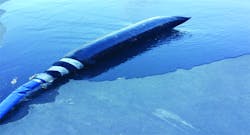In 2012, the U.S. Environmental Protection Agency (EPA) discovered severe environmental impacts of substructures and utility vault discharges on environmental waters. Before 2012, utility companies removed pollutants from substructures by direct discharge to local waters without treatment. As a result, the EPA implemented a general permit to regulate where and how contaminated water was to be discharged to local waters.
Utility companies responded by dewatering flooded substructures and utility vaults using vacuum trucks with treatment and disposal by hazmat facilities. Vacuum truck use involved increased utility rates because of the high costs of the pumper trucks, vault repair delays and downtime, utility worker overtime, cost of power grid rerouting, and hazmat disposal costs. Built-in utility vault sump pumps also were prohibited for use in these substructures.
As of July 1, 2015, the General National Pollutant Discharge Elimination System (NPDES) Permit for Discharge from Utility Vaults and Underground Substructures to Waters of the U.S. officially updated its standards to include the removal of 129 top-priority pollutants before discharge. This EPA regulation also requires removing diesel-range organics, oil-range organics, and gasoline-range organics to stricter water quality criteria limits.
Monitoring by the EPA and utility companies has, indeed, found these pollutants in varying degrees in underground electrical vaults because of runoff from local roadways and illegal dumping. The recent EPA mandate also requires the removal of toxic insecticides, volatile organic compounds and polychlorinated biphenyl contamination from transformers. Table 1 lists the 129 top-priority pollutants on the EPA list for utility vaults. These dissolved pollutants are in addition to oil and grease and total suspended solids.
Solution to problematic discharge
After the EPA raised utility vault water as an environmental concern, discharge of this water required a new treatment solution to allow direct discharge of cleaned water from vaults. Conventional sand and silt filters have been available for sand and debris removal from utility vaults but are ineffective against dissolved hydrocarbons. Some have even been configured with polypropylene or polyester fabric that claimed to absorb small amounts of oil and grease. In the past, utility companies took advantage of the low cost and low efficiency of these sand filters to filter moderately visual dirty water. They are, however, no longer useful or effective in meeting the new regulations.
Read Also: Solid-liquid filtration basics for process engineers
One major Southern California utility partnered with Red Lion Chem Tech in San Diego, California, to develop the Hydrocarbon and Contaminants Removal (HCOR) Filter to solve its discharge problems. The filter is the only single-pass pressure filter on the market that addresses the 129 EPA priority pollutants. It was specifically engineered to effectively remove oil and grease that may accumulate in utility vaults and substructures. The filter uses a portable submersible pump, and the system incorporates a filter sleeve comprised of the following:
- A six-layer polyester fiber to capture hexane extractable materials such as oil, diesel fuel and gasoline
- An inner-sac ion exchange chamber for removing selected toxic heavy metals
- A three-dimensional inner perfusion layer comprised of agglomerated, oleophilic nanomaterials for removing dissolved contaminants, particularly those on the priority pollutants list of the Clean Water Act
Each single-pass pressure filter (see Image 1) contains 1 pound of oleophilic adsorbent with an active nano surface area for hydrocarbon binding of 570,000 square feet.
Use of the filter sleeve helps reduce the use of vacuum trucks, which reduces contaminated water transportation and hazmat disposal fees, shortens vault downtime, reduces the costs of electrical power grid rerouting for prolonged periods of time, and reduces labor costs and delays for utility companies. Overall, use will reduce costs transferred to rate payers.
How it works
The agglomerated, oleophilic nanomaterial adsorbent is found in the filter sleeve in micron-sized aggregates. It creates a clathrate structure that captures the dissolved and undissolved pollutants and chemically binds them. The pollutants do not leach out of the sleeve upon pressure filtration. The nanomaterial adsorbent can capture up to 1,000 times its weight in targeted substances because of its inherently high surface area. The filter’s design prevents the leaching of the agglomerated nanomaterials.
Results
The 129 priority pollutants addressed by the EPA were tested against the single-pass pressure filter using a portable, submersible pump moving up to 400 gallons per minute (gpm). Water samples were collected before and after treatment and submitted to an independent National Environmental Laboratory Accreditation Program-certified independent laboratory for analysis following the required EPA methods. The overall results for the filter sleeve showed an overall concordance of 98.5 percent to EPA water quality testing criteria limits after filtration. Of all the pollutants tested, 97.4 percent were equal to or below the new EPA water quality criteria limits after filtration through the filter sleeve, and the average percent reduction was 90 percent for all pollutants tested. Image 2 shows the collection containers used before and after filtration of the polluted water.
The hydrocarbon- and contaminant-removal filter was also tested on numerous substructures and utility vaults in conjunction with a major Southern California utility company. To test the filter, the contents of a 5,000-gallon vacuum truck used to pump out a utility vault were transported on the day of collection to a contained testing site. Prefiltration water samples were obtained and processed separately under a full chain of custody. Contents of the pump truck were filtered through a filter sleeve under pressure up to 400 gpm, and the post-filtration samples were collected following the chain of custody procedures for the same independent laboratory EPA
analyses performed in the initial study.
Filtered water discharge complied with all EPA-mandated water quality criteria. The filter sleeve was shown as a reliable way to provide protection to the beneficial use of utility vault contaminated water discharged directly to storm drains. It also allowed the utility companies to be in compliance with the enhanced requirements of the NPDES permits for the reduction of pollutants from stormwater runoff collected in utility vaults and substructures.
The single-pass pressure filter system put utility companies back in control of their water discharge operations for on-site, on-demand dewatering needs. In turn, the use of the single-pass, pressure filter will also aid in reducing the use of vacuum trucks and the costs and downtown associated with them.
Allan D. Pronovost, Ph.D., is chief science officer for Red Lion Chem Tech LLC. Pronovost has more than 35 years of experience in science, technology and medicine. He holds a Ph.D. in pathology/virology with a specialty in immunology and is certified in clinical laboratory medicine from Yale University School of Medicine. As a scientist, inventor and clinician, Pronovost has facilitated the introduction of more than 18 industry-first products in diverse fields including in vitro diagnostics, molecular diagnostics, hemostasis/wound healing, materials science and nanotechnology. During his career, he has authored more than 60 patents, 80 papers or abstracts, and two books as well as introduced more than 120 products to the marketplace including 73 successful U.S. Food & Drug Administration submissions. He has held various management positions in companies such as New England Nuclear, DuPont, Johnson & Johnson, Eastman Kodak, Quidel Corp. and Quest Diagnostics.


